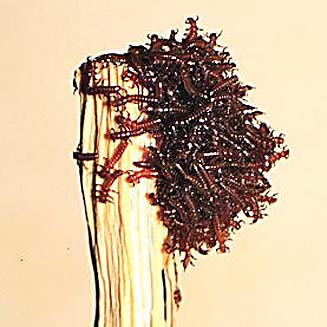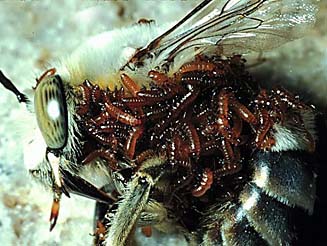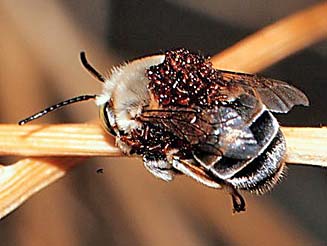|
Beetle larvae that cooperate to mimic amorous bees
Hafernik and Saul-Gershenz (2000) found that cooperative behaviour
in insects is not limited to the social insects such as bees. He found that the
larvae of a certain blister beetle, Meloe franciscanus (Meloidae) also
does it.
Young larvae (triungulins) of the blister beetle
have a remarkable system of finding a bee host, Habropoda pallida (Anthophoridae).
The beetle larvae aggregate together on the vegetation and mimic the appearance
of a female bee. Male bees confuse the larvae aggregate for a female and attempt
to mate. This results in the larval aggregation attaching to the underside of
the male. When the male finally finds a female and mates, the beetle larvae
transfer themselves to the female and get transported back to the nest where
they feed on the pollen collected by the female for her offspring.
|
 |
|
|
Images provided by J. Hafernik. (These species do not occur in southern Africa but they
illustrate yet another fascinating mimicry system in nature). Larvae of the blister beetle Meloe franciscanus aggregate on
the end of plant stems to mimic the appearance of female Habropoda pallida.
|
|
|
 |
 |
|
Male bees pick up larvae from stems
through pseudocopulation and then deposit the larvae on
female bees during mating attempts. Close-up of triungulin
larvae on the underside of a male bee. |
Female bee with triungulin larvae on
her back. These larvae are the result of venereal
transmission from a male bee.
|
Not only does the aggregation of beetle larvae
look like the female bee but it was deduced that pheromones were also emitted by
the larvae as male bees were observed to land and hover next to groups of larvae
before they aggregated. Painted models of the aggregations were also placed
nearby and these were ignored by the male bees.
The question is why has this Meloe species
of blister beetle developed a system such as this? Hafernik and Saul-Gershenz
point out that
Meloe species produce large clutches of larvae (about 3000) and this is
associated with high larval mortality. The study site was situated in a desert
region so it would seem that the mimicry system developed by M. franciscanus enhances its survival
in a harsh environment where bee numbers, flowers and flowering frequency are highly
variable.
In his research on Fideliidae bees in South
Africa, V. B. Whitehead of the South African Museum found Sitaris sp. (Meloidae)
larvae on bees, Fidelia paradoxa (Fideliidae). The beetle larvae in this case merely
transfer singly from the flowers onto the bees and then drop off in the bee
nest.
Reference
Page by Margie Cochrane
|
